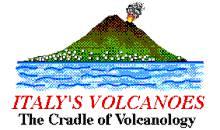 |

A
towering eruption column is rising from the erupting NE Crater, one morning
in January 1978, as the crater produces one of many paroxysmal eruptive
episodes in a series that began in July 1977 and is to last until late-March
1978. This view is from the SE and shows the snow-covered Valle del Bove
in the foreground. Photo by Carmelo Sturiale
The 1974-1978
NE Crater eruptions
|
 |
Stage
1: Persistent Strombolian and effusive activity
from the NE Crater and nearby fissures - September 1974 to January 1977
| Silent
since early April 1971, the NE Crater reawakens with initial vent-clearing
explosions on 29 September 1974, and two days later, mild Strombolian
activity begins to build a small cone within the crater. This photo
was taken by Giuseppe Scarpinati on 1 October 1974 and shows the new
cone in the moment of an explosion ejecting incandescent bombs. The
photo was taken from the rim of the crater |
|
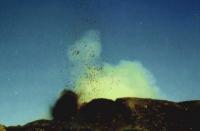 |
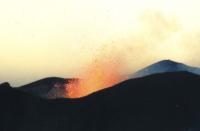 |
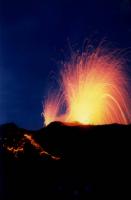 |
| Photos
taken by Giuseppe Scarpinati of the NE Crater in eruption on 13 October
1974, two weeks after its reawakening. Left: Explosion from vent on
the S crater rim, ejecting incandescent bombs and a small ash plume.
Center: NE Crater in Strombolian activity at sunset, probably seen
from the N rim of the Bocca Nuova. Right photo is a classical night
view of Strombolian and effusive activity at the NE Crater |
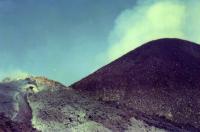 |
More
than four months after its reawakening, the NE Crater continues
to display Strombolian activity from its summit vent (at right)
and slow lava effusion from a vent on its western (?) flank (left
foreground). Its cone has grown significantly in this period. Photo
taken by Giuseppe Scarpinati on 2 February 1975.
|
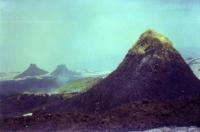 |
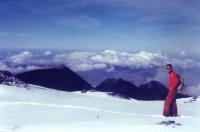 |
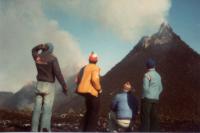 |
| New
eruptive vents become active on 25 February 1975 near Punta Lucia,
about 2 km to the NW of the NE Crater. Top left photo shows a large
hornito formed around one of these vents, photographed on 6 April
1975 by Giuseppe Scarpinati. The two conspicuous cones in the left
background are two large hornitos formed in the 17th century, known
as the "due Pizzi" or "Fratelli Pii". - Another
fissure forms on 29 November 1975 a bit further downslope to the N,
where several spatter cones form (top center photo, with Giuseppe
Scarpinati in the foreground, taken on 3 December 1975). The two photos
at right show spatter cones growing along the eruptive fissure of
29 November 1975, seen here on 28 December 1975. Persons in the foreground
of upper photo indicate scale. Photos by Giuseppe Scarpinati. |
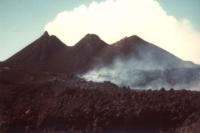 |
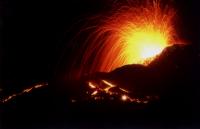 |
Left:
Strombolian activity and lava effusion from the partially collapsed
NE Crater on 5 January 1976, during a lull in the activity of the
29 November 1975 fissure. Activity alternated frequently between
these two eruption sites during 1975-1976. Photo by Giuseppe Scarpinati.
Right: Ash emission, possibly caused by collapse, at the NE Crater
in June 1976, photographed by Giuseppe Scarpinati. Collapse occurred
at this crater during effusive activity from the 29 November 1975
fissure.
|
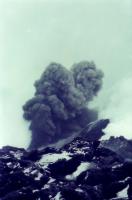 |
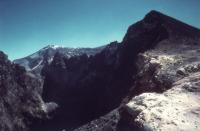 |
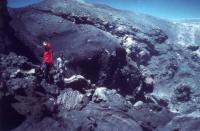 |
| Two
photos of the interior of the NE Crater in (early?) July 1977, during
a period of repose. Much of the large cone formed earlier during the
activity initiated in September 1974 has collapsed, and the crater
has become a vast pit. No activity has occurred since January 1977,
but only a few days later, on 16 July, renewed eruptive activity occurs
at this crater, initiating a series of short-lived but violent paroxysmal
eruptive episodes. Photos were taken by Giuseppe Scarpinati. |
Stage
2: Paroxysmal eruptions from the NE Crater - July 1977 to March 1978
|
#
1 - 16-22 July 1977. Max. length of lava flows: 4 km towards N
# 2 - 5-6 August 1977. Max. length of lava flows: 3 km towards N
# 3 - 14 August 1977. Max. length of lava flows: 4 km towards N
# 4 - 3
November 1977. Max. length of lava flows: 3 km towards NW
# 5 - 7-8
November 1977
# 6 - 14-15
November 1977
# 7 - 21-22
November 1977. Max. length of lava flows: 1.5 km
# 8 - 25
November 1977
# 9 - 6
December 1977. Lava flows towards E
# 10 - 10-13
December 1977. Max. length of lava flows: 6 (?) km
# 11 - 18
December 1977
# 12 - 24-25
December 1977. Lava flows towards NW and E
# 13 - 19
December 1977. Lava flows towards NW and N
# 14 - 2-3
January 1978. Lava flows NNW; NE
Crater is breached on NW
side
# 15 - 4
January 1978.
# 16 - 5
January 1978
# 17 - 7
January 1978. Max. length
of lava flows: 5 (?) km
# 18 - 10
January 1978. Lava flow
uncertain
# 19 - 25-26
March 1978. Max. length of lava flows: 7 km to the NW and N
# 20 - 17-28
March 1978. Max. length of lava flows: 3 km towards N and NW
Strong explosive activity without lava emission occurred on 29 March
1978, after which the NE Crater remained quiet for 2.5 years (until
September 1980)
Data
from Tanguy and Patanè, Bull. Volcanol. 47 (1984): 965-976
|
 |
 |
 |
| Between
July 1977 and late-March 1978, the NE Crater produces about 20 episodes
of paroxysmal eruptive activity, characterized by violent lava fountaining,
tephra production, and emission of fast-moving lava flows. The three
photos above were taken by Carmelo Sturiale during this period. Left
photo shows the NE Crater during a paroxysm in early January (possibly
the one that occurred from the late afternoon of 2 January until the
morning of the 3rd): lava fountains are rising from several vents,
and lava flows from below a breach formed in the NW rim of the crater.
Photo at center is a view of Etna from the home of Sturiale in S.
Agata li Battiati (a town lying near the N margin of Catania) during
another paroxysm of the crater. Right photo is a view of the volcano
from E, with the Valle del Bove in the foreground, and the dark summit
cones in a moment of quiet. The NE Crater cone (the right of the two
dark cones at the summit) is seen to be slightly higher than the steaming
main summit cone - thus Etna is gaining height due to the frequent
paroxsms at the NE Crater. |
 |
 |
 |
| Another
paroxysm at the NE Crater, this time in late-March 1978, photographed
by Carmelo Sturiale. This series of photos was probably taken on or
about 25 March 1978, when the crater resumed its activity after about
2 months of silence to produce several paroxysms in few days, the
last of the series initiated in July 1977. Left photo is a view from
Sturiale's home - note that there is no snow on the mountain after
a relatively mild winter, but as will be seen below, the winter was
not yet over |
 |
 |
 |
| Ash
and lava are issuing from the NE Crater after a night of fresh snow
fall in late March 1978 in the photo at left, taken by Carmelo Sturiale
from the N. Center photo is another view of Etna from the home of
Sturiale showing relatively mild ash emission from the NE Crater at
about the same date. Photo at right shows the NW flank of Etna after
more snow has fallen (therefore this photo was taken after the previous
two), with the conspicuous cinder cone of Monte Maletto in the foreground.
The NE Crater is quiet, but a steaming tongue of lava extends from
it towards the center of the photograph. |
 |
After
the latest paroxysm from the NE Crater (this one occurred on 27-28
March 1978), a dark lava flow extends through snow fields to about
7 km distance from its source, the longest flow known to have been
produced by a summit eruption of Etna. Left photo was taken from near
Randazzo (visible at lower right), on the N side of Etna, right photo
from the area of Maletto on the NW side. Photos by Carmelo Sturiale |
 |
Continue
with
THE 1978 SE CRATER AND VALLE DEL BOVE FLANK
ERUPTIONS
|
